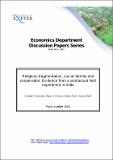| dc.contributor.author | Chakravarty, Surajeet | en |
| dc.contributor.author | Fonseca, Miguel A. | en |
| dc.contributor.author | Ghosh, Sudeep | en |
| dc.contributor.author | Marjit, Sugata | en |
| dc.coverage.spatial | India | en |
| dc.date.accessioned | 2016-06-23T15:08:28Z | |
| dc.date.available | 2016-06-23T15:08:28Z | |
| dc.date.issued | 2015 | en |
| dc.identifier.citation | Chakravarty S., Fonseca M.A., Ghosh S. and Marjit S. (2015) Religious fragmentation, social identity and cooperation: Evidence from a artefactual field experiment in India, Economics Department Discussion Papers Series 15/01. Exeter: University of Exeter. | en |
| dc.identifier.uri | https://opendocs.ids.ac.uk/opendocs/handle/20.500.12413/11927 | |
| dc.description.abstract | We study the role of village-level religious fragmentation on intra- and inter-group
cooperation in India. We report on data on two-player Prisoners Dilemma and Stag
Hunt experiments played by 516 Hindu and Muslim participants in rural India. Our
treatments are the identity of the two players and the degree of village-level religious
heterogeneity. In religiously-heterogeneous villages, cooperation rates in the Prisoners
Dilemma are higher when subjects play with another in-group member for both Hindus
and Muslims, but to a much lesser extent in the Stag Hunt game. This suggests
that positive in-group biases operate primarily on the willingness to achieve socially
efficient outcomes, rather than through beliefs about the actions by one’s counterpart.
Interestingly, cooperation rates among people of the same religion are significantly
lower in homogeneous villages than in fragmented villages in both games. This is
likely because a sense of group identity is only meaningful in the presence of an outgroup.
This, together with little evidence for out-group prejudice in either game, means
religious diversity is beneficial. | EN |
| dc.language.iso | en | en |
| dc.relation.ispartofseries | Economics Department Discussion Papers Series 15/01 | en |
| dc.rights.uri | http://creativecommons.org/licenses/by-nc-nd/4.0/ | en |
| dc.title | Religious fragmentation, social identity and cooperation: Evidence from a artefactual field experiment in India | en |
| dc.type | Series paper (non-IDS) | en |
| dc.identifier.externaluri | https://doi.org/10.35648/20.500.12413/11781/ii144 | |
| dc.identifier.ag | ES/J018643/1 | en |
| dc.identifier.doi | 10.35648/20.500.12413/11781/ii144 | |


